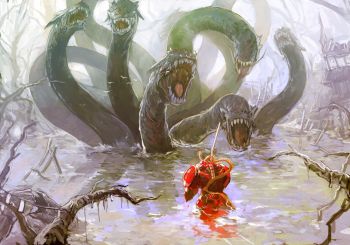Hydra
| Type | Hydra | Fire-breathing Hydra |
Lernean Hydra |
| Species | beast | ||
| No. Appearing | 1 | 1 | 1 |
| Behaviour | solitary | ||
| Range | jungle, subterranean |
ruin | |
| Size | 10 ft. tall | 10 ft. tall | 10 ft. tall |
| Weight | 600-1,400 lbs. | 720-960 lbs. | 1080 lbs. |
| Intelligence | 4 | 4 | 4 |
| Armour Class | 5 | 5 | 5 |
| Hit Dice | 5-12 | 6-8 | 9 |
| Action Points | 3 pts. for body; 1 pt. per head | ||
| Max. Stride | 2 | 2 | 2 |
| THAC0 | 18-14 | 17-16 | 15 |
| Hp/Die | d10, d4+d6 or d12 |
d10 or d4+d6 | d4+d6 |
| Attack Form | 5-12 bites | 6-8 bites | 9 bites |
| Damage | 2-12 | 2-12 | 2-12 |
| Special Attack | venom | breath weapon, venom |
immortal head, regeneration venom |
Hydrae are large, serpentine beasts dwelling in partially or wholly submerged subterranean or ruinous lairs. They are the offspring of Typhon and Echidna; there are well over a hundred of them scattered from the Mediterranean throughout the Middle East and as far away as southern India. The creature has a large, fat body; the rear is about 10 ft. wide and 14 ft. long, ending in a stumpish tail. The body's front is supported on two immense stalk-like legs, similar to a brontosaur. From the forepart of this muscled, leathery mass emerges a forest of snake-like tentacles with ridged or knobbed heads, vaguely remiscent of dragons, with which the beast is purportedly related.
The ponderous body is protected by the quick-moving heads, which have a three-hex reach (15 ft.). The beast can attack in all directions at once. To protect themselves, they prefer to face enemies in water deep enough so that they can submerge, if attacked at a distance, and which hampers enemies who must wade in to fight them hand-to-hand. There is only a 1 in 10 chance of a hydra being caught out of water. The hydra is able to attack simultaneously with all their heads, and up to four heads are able to attack the same target simultaneously.
The hydra's venom requires a saving throw each time a hydra's head successfully hits. A failed save will cause the victim to suffer 2 hit points of damage per round, for six rounds. Further hits can intensify this effect, so that many who have the wherewithal to bear the damage caused by the hydra's bites will succumb to the poison.
Defeating the Hydra
The hydra's hit points are located in its body, which is protected by the hydra's heads. One or more heads will defend a combat hex surrounding the hydra's body, so that until the head is defeated, the body cannot be attacked. Damage done to the heads does not affect the body; the heads must be cut off. This can only be done with an edged weapon. To cut off a head, the attacker must cause 8 or more damage in a single hit. Hits that cause less damage are ignored. As the hydra's heads fall, the body is exposed and can be attacked directly.
Missile weapons and spells can attack the body, but this is why a hydra will keep its body submerged. When a hydra is reduced to less than half its original number of heads, if it is able it will submerge and flee, seeking a place where it can heal and regrow its heads. Following it will mean fighting the beast wholly underwater.
